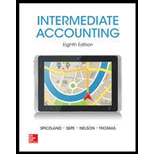
Accounting changes:
Accounting changes are the alterations made to the accounting methods, accounting estimates, accounting principles (or) the reporting entity.
To identify: Accounting changes or an error.
Answer to Problem 20.12P
(a) This is a correction of an error:
| Account title and Explanation | Debit ($) | Credit ($) |
| Prepaid insurance (1) | 21,000 | |
| |
21,000 | |
| (To record the correction of an error). | ||
| Insurance expense (3) | 7,000 | |
| Prepaid insurance | 7,000 | |
| (To record 2016 |
Table (1)
Explanation of Solution
Prepaid insurance is an asset. There is an increase in asset value. Therefore, it is debited.
- Retained earnings are liability. There is an increase in liability value. Therefore, it is credited.
- Insurance expense is an expense. There is an increase in liability value. Therefore, it is debited.
- Prepaid insurance is an asset. There is a decrease in assets value. Therefore, it is credited.
Working notes:
Calculate prepaid insurance:
(1)
Calculate retained earnings:
(2)
Calculate insurance expense:
(3)
- (a) This is a change in estimate:
| Account title and explanations | Debit ($) | Credit ($) |
| 15,000 | ||
| |
15,000 | |
| (To record depreciation adjusting entry for 2016). |
Table (2)
- Depreciation expense is an expense. There is a decrease in liability value. Therefore, it is debited.
- Accumulated depreciation is a contra asset. There is a decrease in asset value.
Working notes:
Calculate annual depreciation after the estimate change:
| Particulars | Amount ($) |
| Cost | 600,000 |
| Less: Depreciation to date
|
(125,000) |
| Un depreciated cost | 475,000 |
| Less: New estimated salvage value | (25,000) |
| To be depreciated | 450,000 |
| New annual depreciation
|
15,000 |
Table (3)
(c) This is a correction of an error:
| Account title and Explanation | Debit ($) | Credit ($) |
| Retained earnings | 25,000 | |
| Inventory | 25,000 | |
| (To record the correction of an error in inventory). |
Table (4)
- Retained earnings are liability. There is a decrease in liability value. Therefore, it is debited.
- Inventory is an asset. There is a decrease in asset value. Therefore, it is credited
- (d) This is a change in accounting principle and is reported retrospectively:
| Account title and Explanation | Debit ($) | Credit ($) |
| Inventory | 960,000 | |
| Retained earnings | 960,000 | |
| (To record a change in accounting principles in inventory). |
Table (5)
- Inventory is an asset. There is an increase in asset value. Therefore, it is debited.
- Retained earnings are liability. There is an increase in liability value. Therefore, it is credited.
- (e) This is a correction of an error:
| Account title and Explanation | Debit ($) | Credit ($) |
| Retained earnings | 15,500 | |
| Compensation expense | 15,500 | |
| (To record the compensation expense). |
Table (6)
- Retained earnings are liability. There is a decrease in liability value. Therefore, it is debited.
- Compensation expense is a liability. There is an increase in liability value. Therefore, it is credited.
- (f) This is a change in estimate resulting from a change in accounting principle and is accounted for prospectively.
| Account title and Explanation | Debit ($) | Credit ($) |
| Depreciation expense (1) | 57,600 | |
| Accumulated depreciation | 57,600 | |
| (To record depreciation). |
Table (7)
- Depreciation expense is an expense. There is a decrease in liability value. Therefore, it is debited.
- Accumulated depreciation is a contra asset. There is a decrease in asset value.
Working notes:
| Particulars | Amount ($) |
| Undepreciated cost | 460,800 |
| Less: Residual value | (0) |
| 460,800 | |
| Depreciated over remaining 8 years | |
|
Annual straight line depreciation 2016-2023 |
57,600 |
Table (8)
- (g) This is a change in estimate:
| Account title and Explanation | Debit ($) | Credit ($) |
| Warranty expense
|
30,000 | |
| Warranty liability | 30,000 | |
| (To record the change in estimate). |
Table (9)
- Warranty expense is an expense. There is an increase in liability value. Therefore, it is debited.
- Estimated warranty liability is a liability. There is an increase in liability value. Therefore, it is credited.
Want to see more full solutions like this?
Chapter 20 Solutions
INTERMEDIATE ACCOUNTING WITH AIR FRANCE-KLM 2013 ANNUAL REPORT
- Jennifer's business reported annual net credit sales of $850,000 and had beginning accounts receivable of $45,000 and ending accounts receivable of $55,000. What is the accounts receivable turnover ratio for Jennifer's business? a. 17.0 b. 15.5 c. 18.9 d. 21.3arrow_forwardI need helparrow_forwardPlease post this question in Account tutors feedarrow_forward
- Merchandise is soldon account to a customer for $82,500, terms GEB shipping point, 3/10, n/30. The seller paid the freight of $6,300. Determine the amount of the sale.arrow_forwardCan you guide me through solving this financial accounting problem using proper techniques?arrow_forwardAccounting solution and questionarrow_forward

 AccountingAccountingISBN:9781337272094Author:WARREN, Carl S., Reeve, James M., Duchac, Jonathan E.Publisher:Cengage Learning,
AccountingAccountingISBN:9781337272094Author:WARREN, Carl S., Reeve, James M., Duchac, Jonathan E.Publisher:Cengage Learning, Accounting Information SystemsAccountingISBN:9781337619202Author:Hall, James A.Publisher:Cengage Learning,
Accounting Information SystemsAccountingISBN:9781337619202Author:Hall, James A.Publisher:Cengage Learning, Horngren's Cost Accounting: A Managerial Emphasis...AccountingISBN:9780134475585Author:Srikant M. Datar, Madhav V. RajanPublisher:PEARSON
Horngren's Cost Accounting: A Managerial Emphasis...AccountingISBN:9780134475585Author:Srikant M. Datar, Madhav V. RajanPublisher:PEARSON Intermediate AccountingAccountingISBN:9781259722660Author:J. David Spiceland, Mark W. Nelson, Wayne M ThomasPublisher:McGraw-Hill Education
Intermediate AccountingAccountingISBN:9781259722660Author:J. David Spiceland, Mark W. Nelson, Wayne M ThomasPublisher:McGraw-Hill Education Financial and Managerial AccountingAccountingISBN:9781259726705Author:John J Wild, Ken W. Shaw, Barbara Chiappetta Fundamental Accounting PrinciplesPublisher:McGraw-Hill Education
Financial and Managerial AccountingAccountingISBN:9781259726705Author:John J Wild, Ken W. Shaw, Barbara Chiappetta Fundamental Accounting PrinciplesPublisher:McGraw-Hill Education





